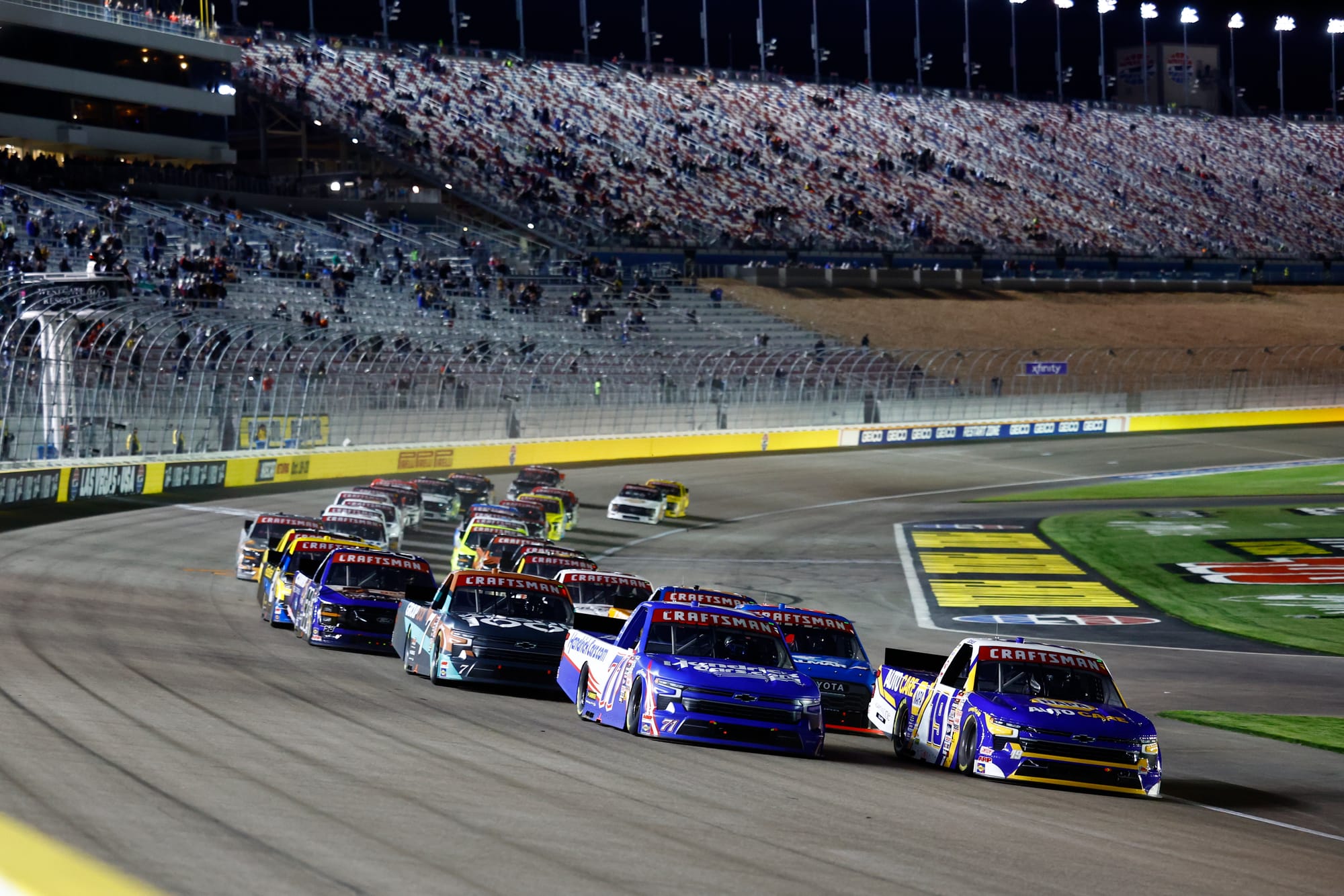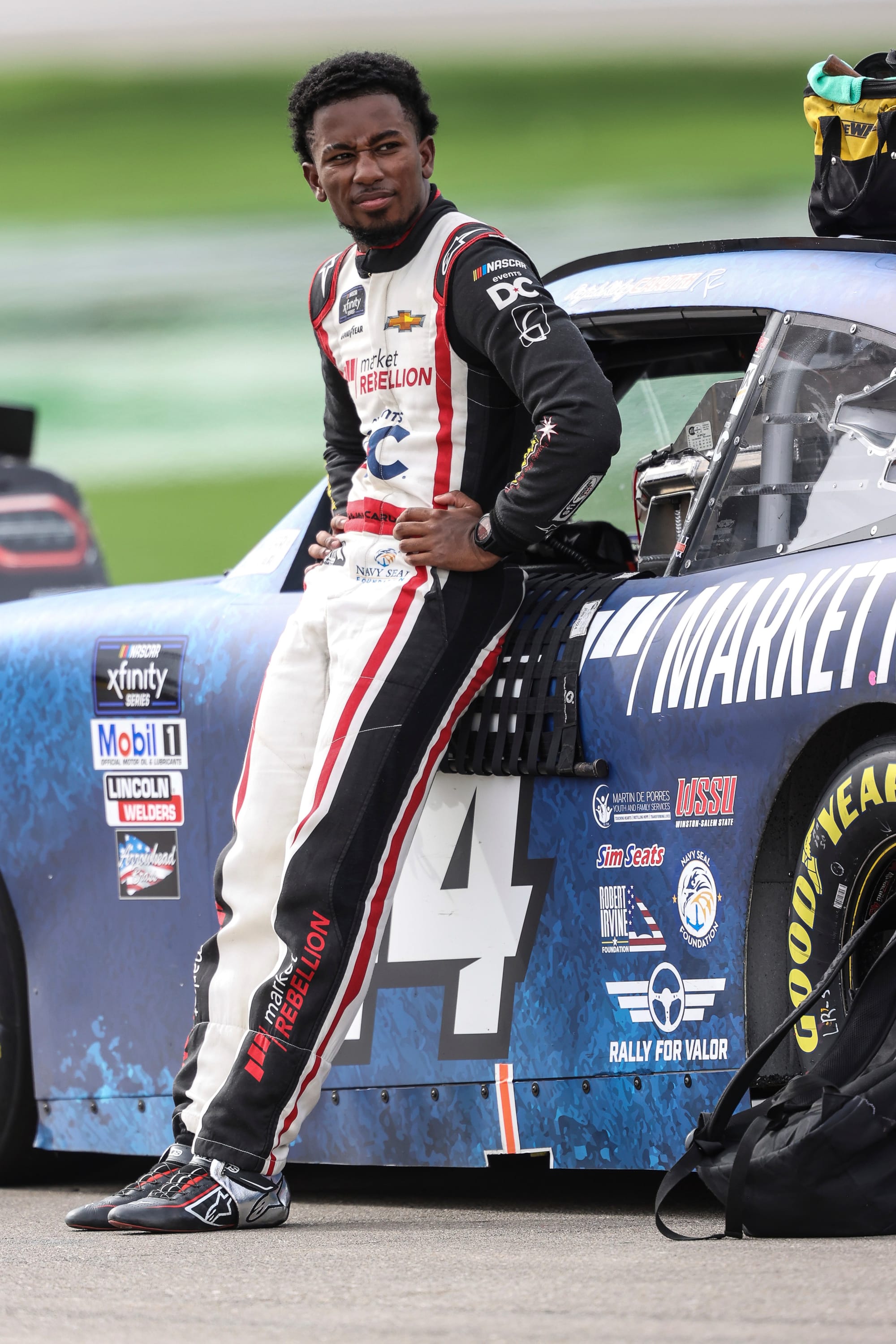Imagine yourself inside “the last great colosseum” at Bristol Motor Speedway in Tennessee. The half-mile oval track is the smallest on the circuit. The banked corners sling you high toward the wall. You’re strapped inside a roll cage. The fire retardant suit is heavy and hot. Sweat seeps onto your forehead and leaks into your eyes, stinging momentarily as the smell of fuel and oil and burning rubber torches your nostrils.
And you suffer through, because your hands and feet must be engaged at all times. The turns come quick and routes are crowded by 35 other trucks in a kaleidoscope of colors and sponsor logos and giant numbers dueling at 72.32 mph. Simultaneously you’re processing accelerating, which means shifting the manual transmission while avoiding the competitor that’s three inches from your door while mindfully watching the truck fishtailing in front of you because disaster looms at any point and your ability to think, process and react is your friend.

Now imagine doing that for the very first time, at some of the longer tracks where your speed is in excess of 180 mph and the V8 engine under your hood is cranking at an unrestricted 700 horsepower and the G forces are torquing your body and your blood is flowing in all the wrong directions.
Rajah Caruth knows this feeling. As one of the hottest drivers on NASCAR’s Craftsman Truck Series, the kid from Washington, D.C. — who just six years ago didn’t have a driver’s license — had to learn it all in the craziest, most dangerous learn-to-drive course in America.

The physicality of racing is something most people don’t appreciate, Rajah says. It’s not just the compression. It’s vibrations from the track. It’s abrasive contact with other drivers. He trains regularly in the gym, strengthening his 5-foot-7 frame to handle both the physicality and the endurance.
“I'd say think about your tallest roller coaster. And you're going slowly up the incline, and then you start going down the hill, and you got that pit in your stomach, and then you get that compression at the bottom. I would say maybe not the pit of your stomach as much, but you get that compression at the bottom of the hill pretty much every lap, especially at the high-banked racetracks.”
And then there’s the equipment.
“The heat, right? We have on multilayered helmets and neck restraints, everything to keep us safe in the cars and trucks. So, overall, it's no joke, but it's a lot of fun.”
His curiosity piqued when his father brought home die cast models for Rajah and his younger sister. He was mesmerized by all things transportation — planes, trains and automobiles.
Then he and his sister saw the Pixar phenomenon “Cars,” which he says today was the starting line for “my infatuation with it. I really became obsessed.”
Moving down the timeline, his passion would be reinforced by a family vacation to Daytona Beach, where he drove a motorized kart for the first time. And then, he learned how to win by losing, taking his lumps at the lowest level regional races, where, he says, “I absolutely sucked. I was not good.”


For the self-described kid who "absolutely sucked" Rajah's fortunes are changing. [AP photos]
Seven years after his own sufferfest, his fortunes have changed. Today, he is all of 22. A college graduate with a bachelor’s in motorsports management and proud son of D.C. In NASCAR’s three-tier system, he races in both the third-tier Craftsman Truck series and the second-tier Xfinity Series, putting him one step away from racing on Sundays in NASCAR’s Cup Series. And he was voted Fan Favorite just a year ago on the truck circuit (trucks were added in 1994 due to growing sales among consumers).
With academics for parents — Dad is employed by Howard University and Mom is at American University — one has to wonder how the former three-sport athlete at School Without Walls in D.C.’s Foggy Bottom district, the same kid who wandered the campus of George Washington University, snacking at the cafe tucked inside the campus hospital, became the first three-time Black national champion and one of the most promising young drivers on the NASCAR Truck Series — all while growing up without a driver’s license.
“I was walking, biking, taking the Metro,” Rajah says.
None of this would have been accessible to Rajah, however, without NASCAR’s Drive for Diversity program. For a kid that grew up comfortable — but not rich — he knows how much his fortunes changed when he applied and was accepted.
“It would have been really hard without it. I think from a driving perspective, I had the passion and did the work and I’m still doing the work. But growing up in the city and not having the funds … like my parents did a great job in terms of providing for my sister and I.
“All our needs are met. We were able to play sports and go on trips and stuff like that, but we weren't a racing family. And that's just a different type of income and expenses that come with traveling to the races … So I was really fortunate to get in that program, to just help elevate me to get those opportunities to drive. I think it would have been really, really hard nowadays to get that opportunity. With all the DEI kind of getting rolled back. And that's pretty unfortunate to see from my perspective.”

For someone with so much potential and a full life in racing in front of him, Rajah recognizes that he’s in a position to help others like him — those who may not have access to opportunities due to economics or other reasons.
“I'm just super thankful for my opportunities and definitely doing my part to help give it back to those that are following in my footsteps. Hopefully I can try to do what I can to help out and add value to what they have going on if more changes continue to happen.”
But thanks to NASCAR’s diversity program, he was afforded a chance to prove himself. And as the accolades pile on and his online merchandise store is sold out of everything, he’s done a little more than take the opportunity and drive off.
He’s become a future pillar of the sport.
Prior to the popularity of Netflix’s F1 Drive to Survive series, the general public’s exposure to the rigors of racing came thanks to Tom Cruise in Days of Thunder, or Will Ferrell and John C. Reilly in Talladega Nights.
It turns out, not every driver gets to fall in love with Nicole Kidman, nor do they get the cash bag by appearing in Wonder Bread commercials. In fact, to earn the chips to drive on Sundays, everyone has to start somewhere.
For Rajah, it was just a few years ago when it was all brand new.
“When I got started, I had a fitness coach that was with the (diversity) program. And then I had a driver coach in the program as well. I really didn't know much. They helped me with literally, like, how to drive a manual car.
“I didn't know how to use a clutch, which is funny if you're a racer because of how basic that is. So, really, from as basic as learning how to use a clutch and flip your steering wheel on and put all your on your safety belts in the correct places to learning about lines and, really how to drive. And then drawing that balance from racing online to real life and what's real, what isn’t real — ultimately I learned a lot. Racing etiquette and professionalism. There’s so much of this sport from a branding and marketing perspective, especially with your team, your partners.”
Rajah got a taste of the big-league tracks with the ARCA Menard Series. He specifically remembers the feeling of the one mile, concrete raceway at Dover, Delaware — “it’s pretty steep, pretty physical.” Next up was Kansas Speedway. At a mile-and-a-half, he calls it “super fast, progressively banked.”

And then, the career-altering lessons he learned. The things you can’t understand or feel from a simulator or a dirt track.
“It's windy there. The surface is a little bit abrasive. So you get some tire wear and things of that nature. It was great for a first mile-and-a-half for me. Just to kind of learn about the different lanes, about the (aerodynamics) and everything because it's so much of an aero game.
“I learned a lot through those first experiences for sure. I mentioned, the aerodynamics … You only get a certain perspective on that on the sim. So it's never going to be acclimated exactly to what we experience on the racetrack. So I think the aero, and just how the behaviors of the cars and trucks and traffic, was an adjustment for me.”
As important as it was to feel the machine underneath him and understand how it handles on the big tracks, Rajah was able to get a taste of the physical dynamics of racing in a way he hadn’t previously.
“How much your body moves in the car and the G-forces and everything and just understanding kind of, how you need to separate what you're feeling and ultimately be able to perform it at a high level.
“So, it was a lot of fun, though, and, I'm super thankful to get the chance to drive, because I think a lot of people haven't had that opportunity. But super thankful to be in this industry and continue to perform,” he says.
The D.C. blood running through his veins couldn’t let the call end without a shoutout to Washington Capitals star Alex Ovechkin, who had recently broken the National Hockey League’s all-time goal scoring record. Rajah also let out an exasperated sigh at the plight of his beloved Wizards.
With icons top of mind, he listed Jimmie Johnson, Bubba Wallace and Lewis Hamilton as drivers he admires.
“I mentioned Bubba, I'd say Ross Chastain as well. Somebody I definitely look up to a lot for just how they are as competitors. But also how they carry themselves off the racetracks and how they've treated me as well.”
He spends the offseason decompressing, noting that being in nature allows him to reset his headspace before the season. Time with family is important as well. At 22, he has really just taken the pole position on his journey, yet has accomplished so much in a compressed timeline.

With that comes expectations — not to mention his popularity means the business and promotional side is tugging at his shirt sleeve constantly. He believes in his talent, and can visualize himself racing on Sundays. The key to that, though, is patience.
“I used to put an expectation on it, but I found myself losing presence at where I was at and not doing the best at my current stage. So my focus kind of shifted, just enjoying the journey and really doing my best at the current level I'm at. So I know that in order to eventually race on Sundays, I've got to be successful where I'm at now.
“So no set timeline. I trust that with having the results and doing things the right way as a sportsman and as a professional, that I'll be able to achieve my dreams and race on Sunday.”
Matthew Fults is author of the award-winning novel, The Scotland Project, available from your favorite bookseller. Its sequel, Messenger for the Dead, is available for pre-order.